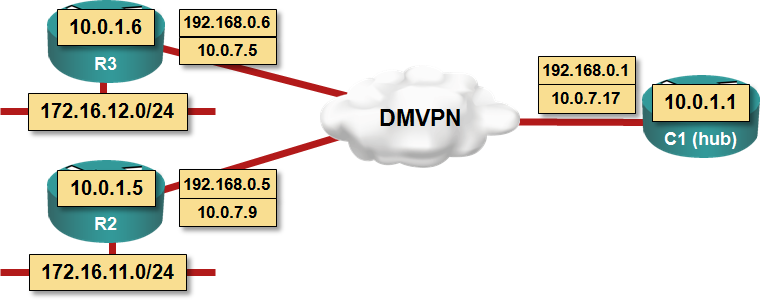DMVPN Spoke NHRP Behavior Changed in IOS Release 15.0M
In the good old days, we (thought we) knew how Phase 2 DMVPN works and what happens when the spoke-to-spoke session cannot be established. As I discovered when developing the lab configurations for the DMVPN: New Features in IOS Release 15 webinar, that behavior has forever changed (and not for the better) sometime in the 12.4T (or 15.0M) release. I blame the introduction of NAT awareness in IOS release 12.4(15)T, but it could be another totally unrelated change.
I’ve set up a small lab network (actually reused the lab configurations you get as part of the DMVPN - From Basics to Scalable Networks or DMVPN New Features webinars) shown in the following diagram to illustrate the change in the behavior. After OSPF populated the routing tables on all routers, I pinged the loopback interface of R3 from R2.

The Old Behavior
A spoke (R2) sends a NHRP request asking for other spoke’s IP address to the hub router. The hub router propagates the NHRP request to the other spoke (R3), which then tries to respond (and build a spoke-to-spoke IPsec tunnel).
If the spoke-to-spoke IPsec tunnel fails to materialize, the two spokes have incomplete (and thus unusable) NHRP entries and the traffic continues to flow over the hub router(s).
R2#sh ip nhrp 192.168.0.6
192.168.0.6/32, Tunnel0 created 00:00:44, expire 00:02:20
Type: incomplete, Flags: negative
Cache hits: 2
R3#sh ip nhrp 192.168.0.5
192.168.0.5/32, Tunnel0 created 00:01:02, expire 00:02:02
Type: incomplete, Flags: negative
Cache hits: 2
The New Behavior
As before, a spoke (R2) sends a NHRP request asking for other spoke’s (R3) IP address to the hub router and the hub router propagates the request to the other spoke. At the same time, the sending spoke (R2) creates a fake NHRP entry pointing to the hub router. The fake NHRP entry has a fixed 3-minute expiration time which cannot be changed (with non-hidden commands, at least) and which does not depend on the configured NHRP timers.
The receiving spoke (R3) gleans its peer IP address and builds its own NHRP entry. If the spoke-to-spoke IPsec tunnel establishment fails to materialize, the sending spoke (R2) retains the fake NHRP entry (pointing to the hub); the receiving spoke (R3) has a regular but unusable NHRP entry in no socket state (because the IPsec tunnel is not there).
R2#sh ip nhrp 192.168.0.6
192.168.0.6/32 via 192.168.0.6
Tunnel0 created 00:00:17, expire 00:02:47
Type: dynamic, Flags: used temporary
NBMA address: 10.0.7.17
R3#sh ip nhrp 192.168.0.5
192.168.0.5/32 via 192.168.0.5
Tunnel1 created 00:00:29, expire 00:00:30
Type: dynamic, Flags: router implicit
NBMA address: 10.0.7.9
(no-socket)
As you can see, the expiration time of the fake NHRP entry is 3 minutes, while the expiration time of the gleaned NHRP entry corresponds to the ip nhrp holdtime value.
Is This a Problem?
Yes it is; it’s a huge problem in some redundant network designs. Read this blog post for more details; they are also explained in my DMVPN webinars.

Right now we are running 12.4(25a).
This was something I haven't seen come into play in any 15.x routers, it was only the 12.4(18e) routers I saw it on.
Then again maybe I a missing what you are trying to point out.
The suspense is killing me.. ;)
I stumbled upon your blog quite recently and this is just an awesome source of info.
Cheers!